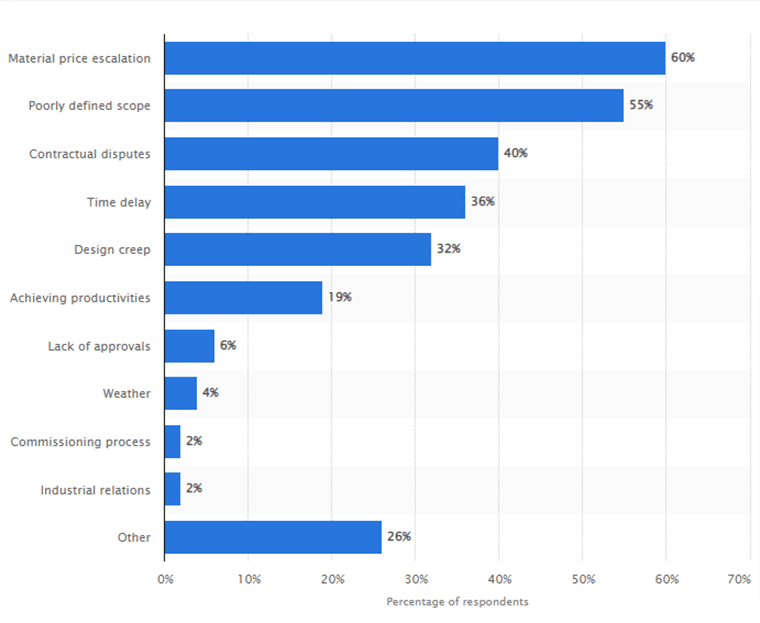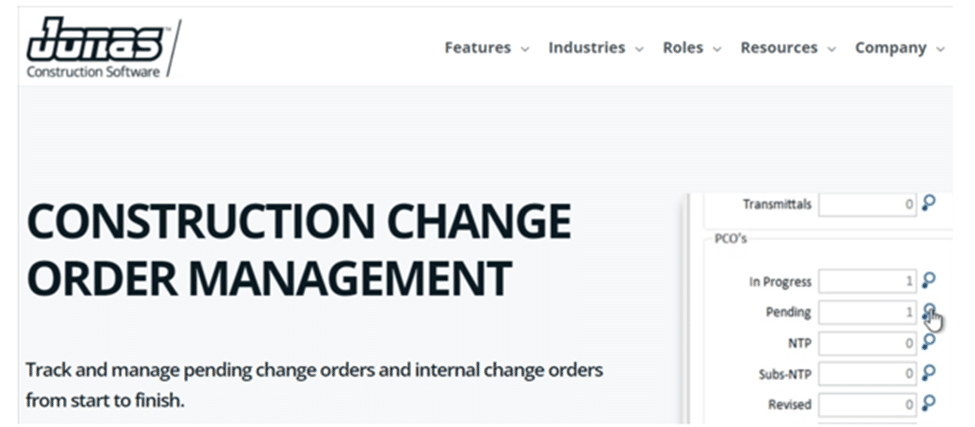The job of a construction project manager may easily be one of the most complex professions in the world.
That’s because the multifaceted nature of construction projects presents managers with different challenges, many of which are specific to the project at hand.
Still, there are some common challenges in construction that all project managers encounter at one point or another.
This article will describe the five most common challenges that construction project managers face and suggest practical solutions for them.
In this article...
Poorly Defined Goals
The issue of poorly defined construction project goals plagues many construction managers, making their job even more difficult.
Addressing it effectively involves clear communication throughout the project, with solid planning before the project starts and flexibility when it’s underway.
According to research, the most common factor contributing to project failure in 37% of the cases is the lack of clear goals.
When the goals of a construction project are poorly defined or unclear, construction project managers are confronted with issues like missed deadlines, uncompleted tasks, duplicate work, confusion, and general miscoordination.
As construction projects tend to have multiple stakeholders (clients, lenders, architects, engineers, contractors, subcontractors, suppliers, etc.) and come with different specific constraints and inherent risks, a lack of clear goals can cause major time and cost overruns or, in the worst case, sink the entire project.
To address this challenge, you should ensure that the goals of a construction project are defined in the earliest stages of project development.
One of the best ways to do this is by using the SMART method of setting goals.

This means that, in the early planning and design of construction projects, the set goals should be:
- Specific
- Measurable
- Achievable
- Relevant
- Time-Bound
This method can make the implementation phase of your construction project much more manageable.
Either way, before the project launch, you should consult everyone included in it, consider their needs and interests, and ensure everyone’s clear on what the project goals are and what their role in achieving them is.
This will ensure buy-in from all project stakeholders and enhance their future cooperation.
Of course, once construction is underway, further challenges will inevitably arise that’ll require your communication skills and flexibility to coordinate between stakeholders in redefining some project goals due to, e.g., design errors, change orders, schedule delays, or cost increases.
All in all, this challenge is best answered by SMART goal-setting in the early stages, coupled with continuous communication and flexibility throughout the construction project lifecycle, thus allowing you to make informed decisions and steer the project toward success.
Restrictive Budget
Budget restrictions can put a lot of pressure on construction project managers, making them deal with numerous challenges while trying to keep the project budget under control.
These can be alleviated by accurate cost estimates, built-in contingencies, regular budget reviews, and one or more software solutions.
Issues like design errors, change orders, labor shortages, or rising material prices can break any project budget, causing delays and cost overruns.
In fact, this is so common in the construction industry that 86% of projects go over budget. And when they do, they exceed it by 32.5% on average.
This means that nine out of ten project managers will have to deal with budget restrictions. You can see the main reasons for cost overruns in construction projects listed below.

As you can see, material price escalation is the leading cause of overruns, which especially rings true in the current situation of galloping prices.
To be ready for such varied challenges, you should first ensure that the budget is based on highly accurate cost estimates.
For example, a misjudged quantity of single construction material can lead to a wrong estimate, which will result in a cost overrun.
Nowadays, these and other budgeting issues can be managed by specialized software like this one.

This cloud-based platform for construction estimating and management is suitable for small-to-medium-sized contractors focused on residential projects.
The second thing is a robust budget with built-in time and cost contingencies.
In other words, if something goes wrong and rework is needed, you’ll be able to pull extra resources to keep the budget in check.
Naturally, sometimes budget restrictions will require concessions somewhere else.
For example, suppose the price of a specific construction material goes up, and the client can’t cover the difference.
In that case, agreeing with the client on using another less expensive material is a viable alternative.
Finally, being ready to review and update your budget, and adjust it to new circumstances, is essential for keeping the project on track despite budget restrictions.
Overall, this challenge is best handled by precise planning, providing for contingencies and safeguards, and ensuring budget flexibility while embracing technological solutions that can ease the pressure stemming from a restrictive budget.
Changing Scope
Managing changes in the project’s scope is one of the most common and demanding challenges tackled by construction project managers.
Fortunately, things like embracing change, managing change orders, and having built-in contingencies can help you successfully deal with the shifts in scope.
Just like in life, change is inevitable when you work in construction. It often happens that the client changes their mind (usually unaware of the material and/or labor costs involved), or the project goals are poorly defined.
For example, the material specified in the project scope can’t be supplied due to shortage, or its price went up, and budget restrictions leave no room for compensation.
Whatever the reason, your job as a construction manager is to effectively address such issues and prevent them from disrupting your entire schedule and budget, bringing down the whole construction project.
So, along with embracing change as an opportunity to excel at your job, the best way to tackle this challenge is to competently handle the change order process, which usually looks like this.

As you can see, after the original construction contract is signed, the change order process involves four steps, each of which can cause further delays and additional costs if not managed correctly.
Regardless of the cause of scope change, proposing practical and actionable solutions to the issue raised and facilitating that all involved parties agree on a specific change order will minimize the negative effects of scope changes on your schedule and budget.
Naturally, the market is overflowing with construction project management software that can streamline this process, ranging from comprehensive to specialized solutions like this one.

Whichever way you go about the scope changes, make sure to have the client sign off on them, and communicate them to the relevant stakeholders.
Another good way to deal with changing scope is to provide for contingencies in your schedule and budget.
Also, it can be wise to agree in advance on some less expensive alternative materials if the ones selected become unavailable or too expensive.
All in all, although scope changes can be demanding, there are many ways to tackle them efficiently and build your reputation as a successful construction project manager.
Unrealistic Expectations from Stakeholders
Unrealistic expectations of the client or other project stakeholders, whether in terms of time, cost, or quality, can snowball into costly construction delays and budget overruns.
To avoid this, construction managers need to be skilled communicators who can temper everybody’s expectations by keeping them real.
Project owners are frequently a source of unrealistic expectations, often because of their lack of experience with the realities of the industry.
For example, a first-time homeowner planning to remodel their home might have a warped sense of both the time and cost of doing so in reality.
Such expectations are best dealt with during the planning and design stages when different options and associated time and costs are clearly explained to the client.
However, if what the client expects simply isn’t feasible, it’s time to use your expertise to explain how their ideas will impact the current schedule and budget and dissuade them or offer alternative solutions.
If such matters are not timely resolved, unnecessary pressures from the client or other project stakeholders, such as your senior management, can kill the motivation and productivity of your workers and force them to cut corners, which can lead to substandard work and even injuries on site.
That’s where you should step in:

In other words, you should use your expertise and communication skills to explain to your client or give feedback to your superiors on why something can’t be done within the deadline or scope they’re proposing, thus protecting your workers, and avoiding potential injuries, rework, or disputes.
However, sometimes unrealistic expectations are ingrained in the project from the outset.
This might occur due to the general competitiveness of the construction industry or specific constraints like project financing.
Such expectations must be realistically considered to find possible solutions.
For example, you can start by investigating the project scope for potential savings or consider using different construction materials or methods to accelerate matters.
Overall, managing everybody’s expectations to keep them realistic is a challenge you can best address by being an efficient communicator and problem-solver.
Time Management
It can be said that time management is the aggregate of all other challenges construction project managers must deal with as part of their job.
Time management is constantly demanding for busy construction managers both on a project and personal level. Solution?
Good planning, effective communication, and appropriate software.
With so many things to consider and coordinate, it’s no wonder that managing a construction project is often a frustrating juggling act for construction managers.
And things are not getting any better, with 88% of contractors facing project delays, according to the Associated General Contractors of America.
Naturally, sound planning is a cornerstone of efficient time management.
If a construction project’s goals are clearly defined, its scope locked, and its scheduling and budgeting include contingencies for unexpected events, managing the ongoing construction becomes much easier.
Of course, construction management software solutions like the one below are great time management tools.

This software lets you keep track of all your crew, documents, images, timesheets, etc., in a single cloud-based application.
But there is also other, more specialized software that can make your time management even more efficient.
For example, the ability to track construction machinery, equipment, and tools between various sites and crews will give you valuable data for smoother time management.
On that note, GoCodes makes tool and equipment tracking easy.

On top of solid planning, communication is one of the essential construction management skills for efficient time management and overall project success.
In fact, it could be said that communication is the construction manager’s most important time management tool.
This includes a broad set of skills like active listening or using online communication tools.
Naturally, there are even more time management practices for construction managers.
However, good planning and clear communication supported by suitable software are excellent starting points for addressing the challenge of time management.
Conclusion
It’s clear construction project managers have their work cut out for them.
The challenges they face can arise from any aspect of a construction project, ranging from poorly defined goals to unrealistic expectations.
Luckily, there are steps construction managers can take to successfully tackle such challenges. We hope you’ve discovered a few of them in this article.




